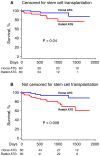Horse versus rabbit antithymocyte globulin in acquired aplastic anemia
- PMID: 21812672
- PMCID: PMC3721503
- DOI: 10.1056/NEJMoa1103975
Horse versus rabbit antithymocyte globulin in acquired aplastic anemia
Erratum in
-
Horse versus Rabbit Antithymocyte Globulin in Acquired Aplastic Anemia.N Engl J Med. 2018 Jun 21;378(25):2450. doi: 10.1056/NEJMx180020. Epub 2018 Jun 13. N Engl J Med. 2018. PMID: 29897839 No abstract available.
Abstract
Background: In severe acquired aplastic anemia, hematopoietic failure is the result of immune-mediated destruction of bone marrow stem and progenitor cells. Immunosuppressive therapy with antithymocyte globulin (ATG) plus cyclosporine is an effective alternative to stem-cell transplantation and improves blood counts and survival. Although horse ATG is the standard therapy, rabbit ATG is more potent in depleting peripheral-blood lymphocytes and is preferred in other clinical circumstances.
Methods: From December 2005 through July 2010, we performed a randomized trial comparing these two ATG formulations in conventional regimens. Patients were treated at a single facility. The primary outcome was hematologic response at 6 months, as determined by blood counts. The study was designed to enroll 60 patients each for the rabbit-ATG and horse-ATG groups and was powered to detect a difference of 25 percentage points in the response rate.
Results: A large, unexpected difference was observed in the rate of hematologic response at 6 months in favor of horse ATG (68%; 95% confidence interval [CI], 56 to 80) as compared with rabbit ATG (37%; 95% CI, 24 to 49; P<0.001). Overall survival at 3 years also differed, with a survival rate of 96% (95% CI, 90 to 100) in the horse-ATG group as compared with 76% (95% CI, 61 to 95) in the rabbit-ATG group (P=0.04) when data were censored at the time of stem-cell transplantation, and 94% (95% CI, 88 to 100) as compared with 70% (95% CI, 56 to 86; P=0.008) in the respective groups when stem-cell-transplantation events were not censored.
Conclusions: In a randomized study, rabbit ATG was inferior to horse ATG as a first treatment for severe aplastic anemia, as indicated by hematologic response and survival. (Funded by the Intramural Research Program of the National Institutes of Health; ClinicalTrials.gov number, NCT00260689.).
Conflict of interest statement
The authors have no conflicts to disclose.
Figures



Comment in
-
Horse versus rabbit antithymocyte globulin in aplastic anemia.N Engl J Med. 2011 Nov 10;365(19):1842; author reply 1843-4. doi: 10.1056/NEJMc1110228. N Engl J Med. 2011. PMID: 22070488 No abstract available.
-
Horse versus rabbit antithymocyte globulin in aplastic anemia.N Engl J Med. 2011 Nov 10;365(19):1842-3; author reply 1843-4. doi: 10.1056/NEJMc1110228. N Engl J Med. 2011. PMID: 22070489 No abstract available.
References
-
- Locasciulli A, Oneto R, Bacigalupo A, et al. Outcome of patients with acquired aplastic anemia given first line bone marrow transplantation or immunosuppressive treatment in the last decade: a report from the European Group for Blood and Marrow Transplantation (EBMT) Haematologica. 2007;92:11–8. - PubMed
-
- Frickhofen N, Kaltwasser JP, Schrezenmeier H, et al. Treatment of aplastic anemia with antilymphocyte globulin and methylprednisolone with or without cyclosporine. The German Aplastic Anemia Study Group. N Engl J Med. 1991;324:1297–304. - PubMed
Publication types
MeSH terms
Substances
Associated data
Grants and funding
LinkOut - more resources
Full Text Sources
Other Literature Sources
Medical
